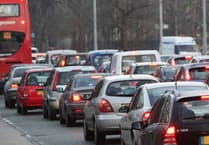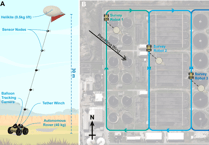The north wind doth blow...
And we shall have snow, as the old nursery rhyme has it. And if we have snow, there will be slush, followed by flood, followed by freeze. Luckily I think a plague of locusts is unlikely to follow.
But it may linger long enough to bring down phone wires, and bend branches to breaking point.
I remember the winter of 1946-47 when the snow lasted so long that footpaths on the common were totally obliterated – lost to bushes heavy with snow blocking the way. This led to walkers trampling around the bushes and when, eventually, the snow melted away, the bushes still stayed over the paths and the once straight tracks had meandered around the previous blockages.
There are warnings about the temptations of walking out onto iced waterways and ponds.
Children love the idea of sliding around, and dogs are often encouraged to join in, leading to roars of laughter at their attempts to walk in a straight and dignified way. But ice can crack so easily and the danger is of ending up trapped under the ice.
Evidently many of the mortalities caused this way originate in desperate owners trying to save their pets which have disappeared under the ice. Luckily these days many more people now keep their dogs on leads. At least near roads.
Let’s hope they keep them on long leads by frozen water and could thus probably be able heave them out should the ice collapse beneath them.
Then there is the melting snow and the ditches filled to capacity, some partially blocked by vegetation borne down by the weight of snow. Puddles on roads appear.
I have often noticed that almost anywhere in the borough where there is a pedestrian crossing, a dipped kerb to facilitate such a crossing, or a bus stop, then that place will be marked by a puddle.
Puddles hide potholes, making motoring and, especially, cycling, more hazardous than ever. I understand that Surrey has more than five per cent of all potholes in the country.
I was interested to learn that police in Derbyshire were “hunting a motorist who soaked an entire family including a baby in a pushchair by speeding through a large puddle”.
Splashing a pedestrian by driving through a puddle is an offence, with fines up to £5,000 and nine penalty points on the licence.
There may be no direct mention of this in the Highway Code, but a driver could well be had up for driving without care and attention. Or get a ticket for a public order offence.
The problem is that unless the driver stops you are unlikely to get the registration of the vehicle concerned whilst wiping dirty puddle-water from your face.
The Scarlet Banksy
Baroness Orczy’s play, book and, later, film The Scarlet Pimpernel, tells of an apparently foppish aristocrat leading a double life under the nom de guerre of that small, insignificant flower, and constantly hounded by the French authorities during The Reign of Terror.
“They seek him here, they seek him there. Those Frenchies seek him everywhere. Is he in heaven or is he in hell? That damned elusive Pimpernel.” These words are quoted throughout the Pimpernel story.
I don’t know of any derring-do by the artist known as Banksy but he does tend to be every bit elusive as the Scarlet Pimpernel, although instead of leaving a representative of a small scarlet flower, Banksy tends to leave considerably larger stencilled pictures in very public places.
More light will be shown on the publicity-adverse artist at a lecture to be given by The Arts Society Mayford (TASM) when the story will be told of Banksy’s humble beginnings as a tagger on the streets of Bristol in the 1980s to one of the most recognisable names in the art world.
Pepe Martinez, a London qualified blue badge tourist guide, will talk about Banksy – Fraud or Genius and explore the reasons behind his incredible rise, looking at some of his famous stunts, discussing what his influence has been on the art market today and looking at what his legacy, if any, might be.
The lecture is on Thursday, February 8, 2024 at 10.30am at the Welcome Church, 1-5 Church Street West, Woking, GU21 6DJ.
Lectures are free for TASM members, but cost £10 for non-members.
Anyone wishing to visit should contact Richard Brace on 01932 344305 or [email protected]
Those far away places...
With strange sounding names. That’s the way the song has it but I doubt that Fairoaks strikes a world traveller as a strange-sounding name.
I was surprised to read that during 2023, Fairoaks could claim to be an intercontinental airfield as in addition to flights within the United Kingdom, the Channel Islands and the Isle of Man, flights took place to or from 17 countries and 160 destinations. That includes destinations within Europe and Africa.
Another interesting statistic is that the total number of destinations served by Fairoaks exceeded the number of destinations served by Heathrow. So perhaps Bing Crosby could have found some strange-sounding names among those places.
Before you rush out to buy earplugs it is good to know that as a condition imposed when planning permission was granted for the runway, a maximum of 10,000 movements are permitted in any one calendar month, and that Fairoaks continues to fall well below the permitted maximum number of movements.
Although it might be pleasant to think that one could simply drive to Chobham, hop an a plane, and end up in Timbuktu, that is not going to come about.
So remember to leave home in good time to allow for traffic jams, road works, and heavy traffic on the route to Heathrow or Gatwick to be able to arrive a good two hours before your flight is due to leave. Or three hours if you are going on a long-haul flight.
And I should inform you that not all the aircraft movements at Fairoaks are of passengers flying to glamorous destinations, but of goods being flown around the place. A pity for some time ago I disclosed, on this page, that Fairoaks Airport was about to be renamed HG Wells International Airport. Of course, that was in an April 1 issue.




